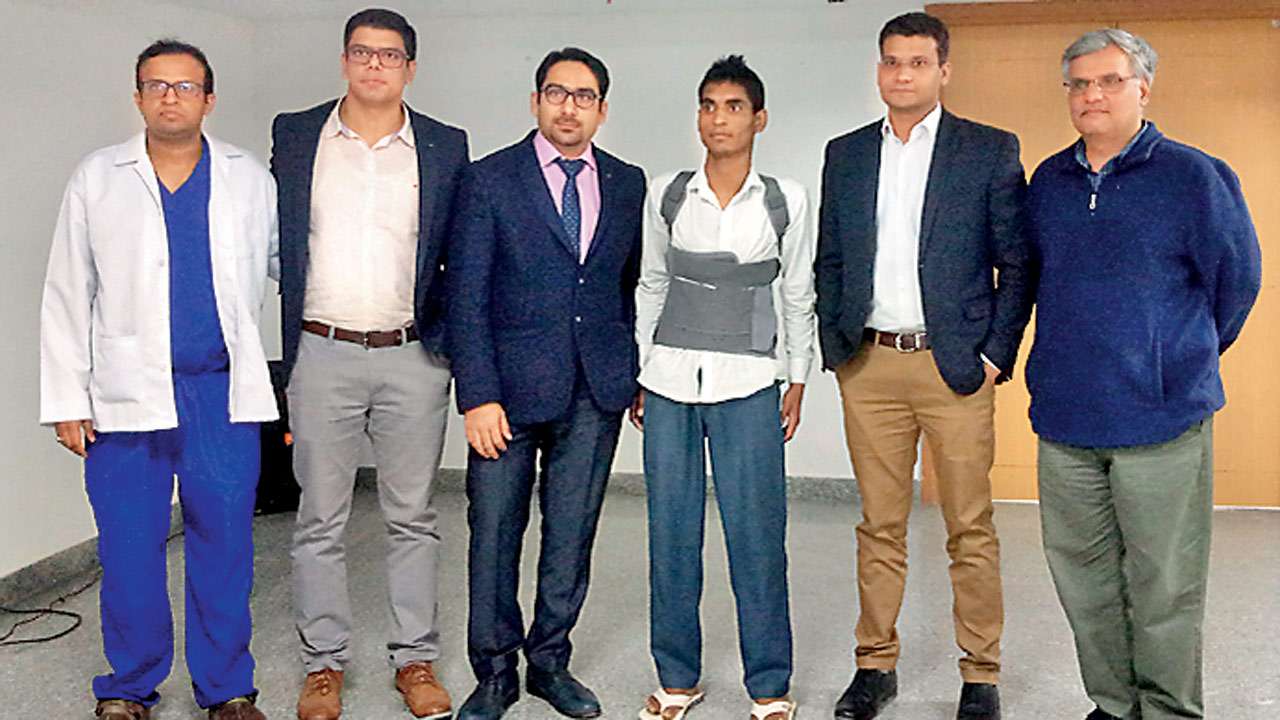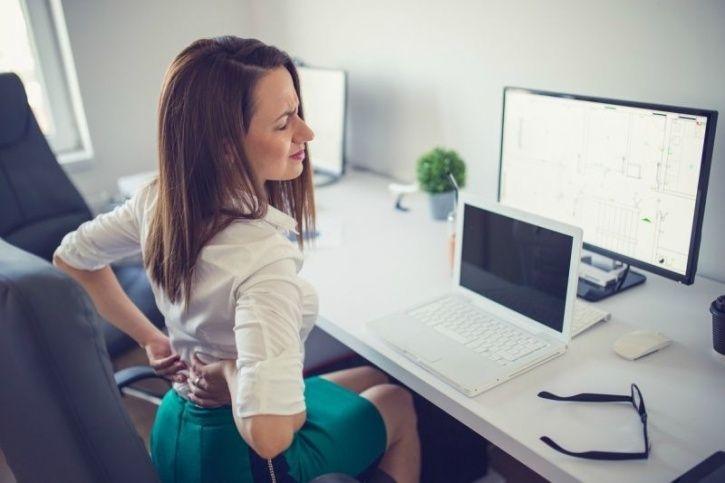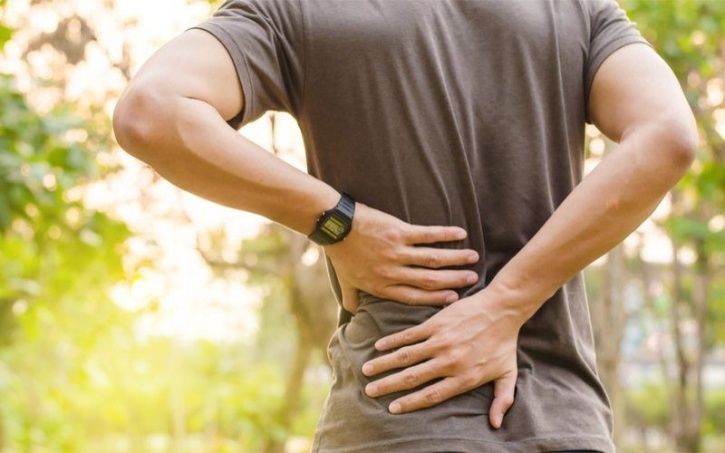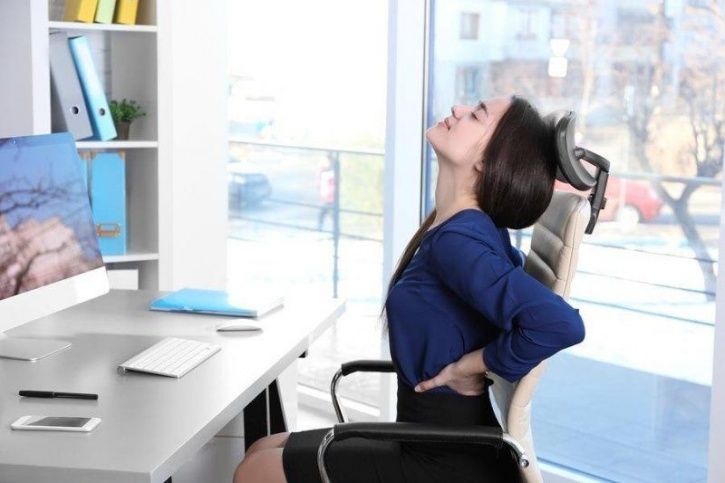Ms Nur Afifah is believed to have one of the most severe cases of scoliosis here (see X-rays above). After a 13-hour operation in April, she now has three metal rods and 19 screws in her spine, but she no longer battles excruciating pain every day and has learnt to accept her condition and be comfortable in her own skin.
 Ms Jasmine Liew (in red dress), co-founder and president of Scoliosis Support Singapore, with (from left) Ms Nur Afifah Mohamed Ali, Ms Cheryl Lim and Meagan Ho. All four suffer from scoliosis - a sideways curvature of the spine.
Ms Jasmine Liew (in red dress), co-founder and president of Scoliosis Support Singapore, with (from left) Ms Nur Afifah Mohamed Ali, Ms Cheryl Lim and Meagan Ho. All four suffer from scoliosis - a sideways curvature of the spine.
 Ms Nur Afifah is believed to have one of the most severe cases of scoliosis here (see X-rays above). After a 13-hour operation in April, she now has three metal rods and 19 screws in her spine, but she no longer battles excruciating pain every day and has learnt to accept her condition and be comfortable in her own skin. Ms Jasmine Liew (in red dress), co-founder and president of Scoliosis Support Singapore, with (from left) Ms Nur Afifah Mohamed Ali, Ms Cheryl Lim and Meagan Ho. All four suffer from scoliosis - a sideways curvature of the spine.
Ms Nur Afifah is believed to have one of the most severe cases of scoliosis here (see X-rays above). After a 13-hour operation in April, she now has three metal rods and 19 screws in her spine, but she no longer battles excruciating pain every day and has learnt to accept her condition and be comfortable in her own skin. Ms Jasmine Liew (in red dress), co-founder and president of Scoliosis Support Singapore, with (from left) Ms Nur Afifah Mohamed Ali, Ms Cheryl Lim and Meagan Ho. All four suffer from scoliosis - a sideways curvature of the spine.
Support group for people with scoliosis grows from 10 members in 2005 to over 300 now
She had a spine so curved that even when she was standing upright, it seemed like she was bowing.
The weight of people's stares, coupled with her extremely hunched posture, made her look down towards the ground often.
Ms Nur Afifah Mohamed Ali, 28, is believed to have one of the most severe cases of scoliosis - a sideways curvature of the spine - here.
A curvature greater than 40 degrees is seen as severe; in 2014, Ms Afifah was told the top part of her spine had a 120-degree curvature while the bottom was 60 degrees.
After years of being called names like "hunchback", "old lady" and "camel", Ms Afifah has now regained 7cm and can walk a little taller at 1.55cm, thanks to a 13-hour operation at Singapore General Hospital in April this year.
She now has three metal rods and 19 screws in her spine. But the curvature has got better - at 100 degrees - and she no longer battles excruciating pain every day.
"I have learnt to accept my condition and be comfortable in my own skin," said Ms Afifah, a freelance photographer.
"Now I can literally stand up and answer to the bullies who used to make fun of me," she added.
Scoliosis was in the spotlight last month when Britain's Princess Eugenie bared a surgical scar in a low-back dress at her wedding and spoke about her experience with the condition.
For Ms Afifah, the journey to self-acceptance was a long one. Even after her surgery, she felt depressed and went for counselling.
DARING TO BARE
My parents always advise me not to wear clothes that will reveal the scar so I was not confident of showing it in public. But, gradually, I have begun wearing low-slung tops and not been so hung up about how others view me.
MS CHERYL LIM, an undergraduate who has had three operations to correct her spine. She was moved by Princess Eugenie's decision to display her back scar (above) at her wedding.
She fears that her condition may worsen in the future, leading her to need a wheelchair or have breathing difficulties.
"The condition not only affected me physically, but also emotionally as I had to battle with insecurity and live with uncertainty," she said.
Her boyfriend broke up with her two years ago, saying he was sick of his friends always staring at her and her "whining" about being in pain.
Back in Primary 4, Ms Afifah, the youngest of three children, was already walking sideways due to the pain in her back. Her mother works as a cleaner, while her father, who also worked as a cleaner, died of a heart attack when she was 16.
But it was only in 2006 after her mother took her to the doctor that the then Secondary 4 student was diagnosed with scoliosis. She went through an eight-hour surgery to correct the 54-degree curvature in the bottom part of her spine.
After the surgery, she could walk without tripping or falling but her condition got worse over the years.
By 2013, doctors from several hospitals did not want to operate on her as her case was too complicated.
She was later found to have a cyst in the spinal cord and acromegaly, where the pituitary gland produces too much growth hormone during adulthood. This means she has abnormally large hands and feet - her shoe size is 42 - and the growth has affected her spine.
Dr Reuben Soh from Singapore General Hospital, however, was willing to treat her and undertook operations to correct her spine and remove part of her rib, which had been deformed by her condition.
Scoliosis Support Singapore, the only such group here, provides support to those with the condition.
Co-founder and president Jasmine Liew, 40, started the group with fewer than 10 members in 2005 and it now has more than 300. They organise twice-yearly sharing sessions, give talks and make follow-up calls to members who require more information or support.
"Back then, there was not much information and few people available to talk to about the condition," said Ms Liew, who also has scoliosis.
Ms Cheryl Lim, 20, an undergraduate who has had three operations to correct her spine, said she was moved by Princess Eugenie's decision to display her back scar.
She said: "My parents always advise me not to wear clothes that will reveal the scar so I was not confident of showing it in public. But, gradually, I have begun wearing low-slung tops and not been so hung up about how others view me."
Meagan Ho, 15, of Raffles Girls' School said her scoliosis has prompted her to advocate for people with the condition. "There are over 40 students with scoliosis in my school and so I formed a project group to raise awareness of the condition and promote treatment and good spine care," she said.
Likewise, Ms Afifah has tried not to let her spine get her down.
She has been volunteering with the Singapore Civil Defence Force, giving monthly public education talks on cardiopulmonary resuscitation (CPR) and first-aid skills for the past 10 years, even though she was rejected from becoming a full-time paramedic due to her condition.
She said: "I hope society will empathise and support people with scoliosis so that the condition will not take over their lives but they will still be able to live out their potential."
•KK Women's and Children's Hospital and Singapore General Hospital are organising a free public forum on scoliosis at Suntec City Convention Centre on Nov 24.
Source : Strait Times , Singapore - 11 ov 2018














